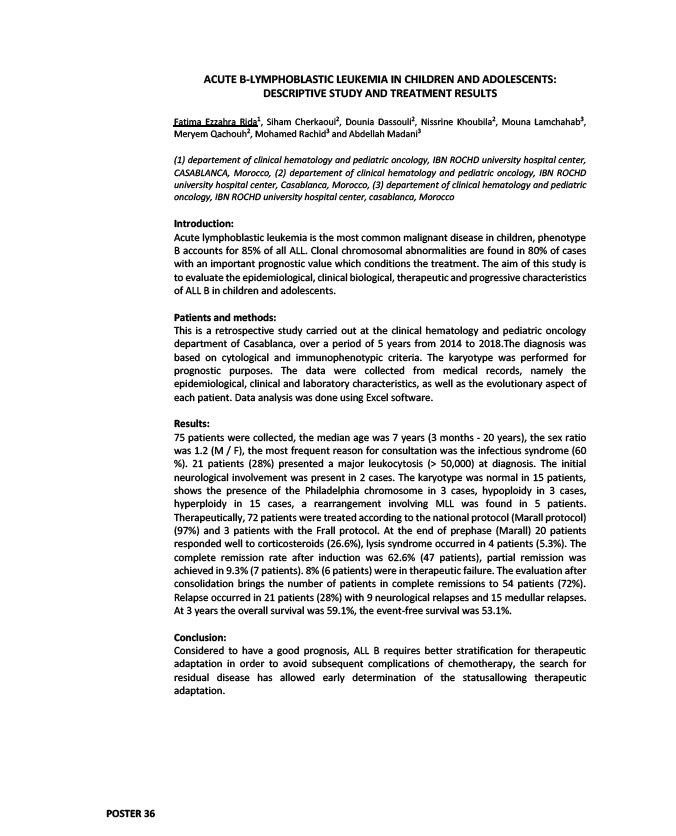
ACUTE B-LYMPHOBLASTIC LEUKEMIA IN CHILDREN AND ADOLESCENTS:
DESCRIPTIVE STUDY AND TREATMENT RESULTS
Fatima Ezzahra Rida1, Siham Cherkaoui2, Dounia Dassouli2, Nissrine Khoubila2, Mouna Lamchahab3,
Meryem Qachouh2, Mohamed Rachid3 and Abdellah Madani3
(1) departement of clinical hematology and pediatric oncology, IBN ROCHD university hospital center,
CASABLANCA, Morocco, (2) departement of clinical hematology and pediatric oncology, IBN ROCHD
university hospital center, Casablanca, Morocco, (3) departement of clinical hematology and pediatric
oncology, IBN ROCHD university hospital center, casablanca, Morocco
Introduction:
Acute lymphoblastic leukemia is the most common malignant disease in children, phenotype
B accounts for 85% of all ALL. Clonal chromosomal abnormalities are found in 80% of cases
with an important prognostic value which conditions the treatment. The aim of this study is
to evaluate the epidemiological, clinical biological, therapeutic and progressive characteristics
of ALL B in children and adolescents.
Patients and methods:
This is a retrospective study carried out at the clinical hematology and pediatric oncology
department of Casablanca, over a period of 5 years from 2014 to 2018.The diagnosis was
based on cytological and immunophenotypic criteria. The karyotype was performed for
prognostic purposes. The data were collected from medical records, namely the
epidemiological, clinical and laboratory characteristics, as well as the evolutionary aspect of
each patient. Data analysis was done using Excel software.
Results:
75 patients were collected, the median age was 7 years (3 months - 20 years), the sex ratio
was 1.2 (M / F), the most frequent reason for consultation was the infectious syndrome (60
%). 21 patients (28%) presented a major leukocytosis (> 50,000) at diagnosis. The initial
neurological involvement was present in 2 cases. The karyotype was normal in 15 patients,
shows the presence of the Philadelphia chromosome in 3 cases, hypoploidy in 3 cases,
hyperploidy in 15 cases, a rearrangement involving MLL was found in 5 patients.
Therapeutically, 72 patients were treated according to the national protocol (Marall protocol)
(97%) and 3 patients with the Frall protocol. At the end of prephase (Marall) 20 patients
responded well to corticosteroids (26.6%), lysis syndrome occurred in 4 patients (5.3%). The
complete remission rate after induction was 62.6% (47 patients), partial remission was
achieved in 9.3% (7 patients). 8% (6 patients) were in therapeutic failure. The evaluation after
consolidation brings the number of patients in complete remissions to 54 patients (72%).
Relapse occurred in 21 patients (28%) with 9 neurological relapses and 15 medullar relapses.
At 3 years the overall survival was 59.1%, the event-free survival was 53.1%.
Conclusion:
Considered to have a good prognosis, ALL B requires better stratification for therapeutic
adaptation in order to avoid subsequent complications of chemotherapy, the search for
residual disease has allowed early determination of the statusallowing therapeutic
adaptation.
POSTER 36